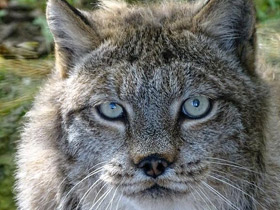The Canada lynx or Canadian lynx (Lynx canadensis)
The Canada lynx (Lynx canadensis), or Canadian lynx, is one of the four living species in the genus Lynx. The Canada lynx was first described by Robert Kerr in 1792. Three subspecies have been proposed, but their validity is doubted; it is mostly considered a monotypic species.
Taxonomy
The scientific name Felis lynx canadensis was proposed by Robert Kerr in 1792 who described a lynx from Canada. In the 19th and early 20th centuries, several lynx zoological specimens were described:
- Lynx subsolanus was proposed by Outram Bangs in 1897 for a lynx skin and skull collected near Codroy, Newfoundland.
- Lynx canadensis mollipilosus was proposed by Witmer Stone in 1900 who described a skull and a dark brown skin of a male lynx killed near Wainwright, Alaska.
The placement of the Canada lynx in the genus Lynx was supported by Gerrit Miller in 1912. Until as late as the early 2000s, scientists were divided over whether Lynx should be considered a subgenus of Felis, or a subfamily itself; some even doubted if the Canada lynx should be considered a species on its own. It was recognized by Wallace Christopher Wozencraft in 2005 as a valid Lynx species along with the bobcat (Lynx rufus), the Eurasian lynx (Lynx lynx) and the Iberian lynx (Lynx pardinus). Wozencraft recognized three subspecies of the Canada lynx:
- Lynx canadensis canadensis in Canadian mainland;
- Lynx canadensis subsolanus in Newfoundland;
- Lynx canadensis mollipilosus in Alaska.
The validity of the subspecific status of the Newfoundland lynx was questioned in 1975, as results of a study of coat colour, cranial measurements and weights of Canada lynx specimens showed that the standard measurements are not significantly distinct, apart from a few variations like the Newfoundland lynx's darker coat.
In 2017, the Cat Specialist Group considered the Canada lynx a monotypic species, since it shows little morphological or genetic differences.
The lynx population on Newfoundland is thought to have genetically diverged from the mainland Canada lynx around 20,000 to 33,000 years ago following the Last Glacial Period.
Distribution
Lynx canadensis is a species of carnivorous mammal in the family Felidae. Its closest relative is the boreal lynx (Lynx lynx), although it can interbreed successfully with any of the other three species in the genus Lynx.
Lynx canadensis is common in forested areas of Alaska and Canada, as well as in Montana, Idaho, Washington and Colorado.
Appearance
This species Lynx canadensis is half the size of the lynx: length 86-117 cm, height at withers 60-65 cm, weight 8-14 kg (in captivity up to 20 kg). The colour of its coat is greyish-brown, reddish in summer; it has white stripes scattered on the ground, which give the impression of being dusted with snow. It may be light blue in colour.
Nutrition
Lynx canadensis feeds mainly on hares; population size depends on population growth or decline. Rodents (squirrels, mice, beavers), deer, foxes and a variety of birds supplement its diet.
Lifestyle and reproduction
Lynx canadensis prefer to live alone, except during the breeding season. Pregnancy lasts 63-70 days. In May-June (rarely in July), females give birth to 1 to 5 young. They become independent and separate from their mother at 10 months of age, usually in March-April. Young lynx reach sexual maturity at 10-23 months of age. Under natural conditions, they live up to 10-15 years.
















































